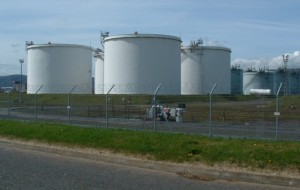 Both WTI and Brent futures were relatively steady during early trading in Europe today. Yesterday the US government revealed weekly readings on oil inventories, pointing a sizable drop at Cushing, which boosted crude contracts. Elsewhere, the US economy has been quite supportive of oil outlooks, with US stocks recording all-time highs.
Both WTI and Brent futures were relatively steady during early trading in Europe today. Yesterday the US government revealed weekly readings on oil inventories, pointing a sizable drop at Cushing, which boosted crude contracts. Elsewhere, the US economy has been quite supportive of oil outlooks, with US stocks recording all-time highs.
West Texas Intermediate futures for settlement in July traded for $103.29 per barrel at 7:47 GMT on the New York Mercantile Exchange, down 0.28%. Prices ranged from $103.26 to $103.56 per barrel. Yesterday the US benchmark added 0.84% with support from the US oil report, which revealed big draws from Cushing. So far this week the contract has fallen by 0.73%, though it did near a three-month peak at $104.50 per barrel.
Meanwhile on the ICE in London, Brent futures due in July recorded a 0.01% drop to trade for $109.96 per barrel at 7:38 GMT. Daily high and low stood at $110.13 and $109.86 per barrel, respectively. Brent’s premium to WTI stood at $6.67, widening Thursdays closing margin of $6.39. Yesterday the European brand gained 0.15%, and so far this week the contract has lost 0.51%.
US inventories
The weekly Energy Information Administration report on oil inventories in the US for the week ended May 23 was released yesterday. Commercial crude oil stockpiles had gained 1.657 million barrels to stand at 393 million barrels, after for the previous week stocks had declined by 7.226 million barrels. The private American Petroleum Institute (API) had suggested a 3.490 million gain, while a Bloomberg survey projected 500 000 barrel growth. A Reuters poll estimated a 700 000 barrel increase.
Domestic production added 38 000 barrels per day (bpd) to average 8.472 bpd, after last week output had gained a further 6 000 bpd. Meanwhile, imports added the massive 1.340 million bpd to average 7.809 bpd, after a sharp decline of 0.658 million bpd for the previous reading.
Inventories at Cushing, Oklahoma, the delivery point of the New York WTI contract, dropped to 21.7 million barrels, a decline of 1.5 million, after a further 200 000 draw for the previous reading, to log the lowest level since November 2008. Meanwhile, hubs at the Gulf Coast added 3.1 million for a figure of 213.1 million barrels, after dropping 5.7 million for the previous week.
“Inventories tell us we’re awash but the market wants to believe in demand,” said for Bloomberg Jonathan Barratt, chief investment officer at Ayers Alliance Securities in Sydney. “Every time oil moves lower it holds and that tells us the market wants to buy. We could be in for a sustained price increase.”
Motor gasoline inventories were reported at 211.6 million barrels, to log a drop of 1.8 million, after a near 1 million growth for the week through May 16. API had reported a 1.440 million decline for gasoline. Distillates were almost unchanged at 116.1 million barrels, after a 3.4 million growth last week, while API had projected a 0.8 million growth.
Refinery utilization rate was at 89.9%, adding 1.2% after a slight slowdown was recorded in the previous reading. Gasoline production in US refineries averaged 9.526 bpd, falling by 66 000 bpd, after last week a further 14 000 bpd drop was logged. Imports of gasoline decreased by 272 000 bpd to stand at 725 000 bpd, after a 120 000 growth was reported in the previous report. Distillates production was almost unchanged at 4.990 million bpd, after a 91 000 bpd gain last week, while imports added fell to 148 000 bpd, from 178 000 for the week ended May 16.
“Better gasoline demand bodes well for the U.S. economy,” said for Reuters Tony Nunan, oil risk manager at Mitsubishi Corp in Tokyo. “Overall, I see oil supported by geopolitical tensions and an improving demand outlook.”
US economy
Yesterday the US, the worlds top oil consumer, accounting for more than 21% of total demand, released several economic reports. The Bureau of Economic Analysis reported its revised figure on US Gross Domestic Product. GDP growth for the first quarter of 2014 was downgraded from the 0.1% initial figure to -1.0% on a quarterly basis. The brutal winter had withered down economic activities in the US, and a relatively negative reading was expected.
Elsewhere, initial applications for unemployment benefits for the week ended May 24 were reported at 300 000, beating expectations of a 318 000 standing, and improving on the 326 000 for the previous reading. Meanwhile, continuing jobless claims for the seven days through May 17 beat expectations to stand at 2.631 million, down from 2.648 million for the previous week.
Also yesterday, pending home sales for April were revealed to have added 0.4% on a monthly basis, short of the expected 1.0% gain, after a 3.4% growth for March.
Earlier this week, durable goods orders scored better than expected, while consumer confidence and services PMI were much better than previous readings, boosting sentiment for the world’s top oil-consuming economy.
US stocks continued to register record highs. On Thursdays Wall Street session, both Standard and Poor 500 and Nasdaq 100 closed for an all-time high, while Dow 30 was only 0.10% short of the highest level.
Later today more US data is due. Personal income, which is a leading indicator for spending, for the month of April has probably increased by 0.3% on a monthly basis, after a further 0.5% in March. Personal spending, which in turn is a leading indicator for consumer inflation, is projected to have grown by 0.2% since March, after logging 0.9% for the previous month.
Also, Chicago’s PMI for May will be reported, with expectations of a contraction to a standing of 61.0, down from 63.0 for April. Michigan’s consumer sentiment for May has probably added to 82.5, after 81.8 for April.
Ukraine
Ukraine saw some of the fiercest fighting this week, since the conflict began earlier this year. Yesterday rebels shot down a military helicopter, killing at least 12 Ukrainian soldiers, including a high-ranking general, who headed special combat training for the newly created National Guard. On Monday, separatist fighters assaulted Donetsk airport, only to suffer more than 100 dead, according to the “Donetsk Peoples Republic” press office.
The conflict seems to have been galvanized by the presidential election in Ukraine, which took place last Sunday, May 25. The winner, collecting 54% of the vote, is billionaire and former foreign minister Petro Poroshenko. He vowed to punish the rebels, and to have the “anti-terrorist operation over within hours, not months”. He has previously said that he would also never recognize Russias annexation of the Ukrainian Black Sea peninsula of Crimea. Mr Poroshenko will be inaugurated on June 7.
Technical view
According to Binary Tribune’s daily analysis, in case the West Texas Intermediate July future on the NYMEX breaches the first resistance level at $104.14, it probably will continue up to test $104.71. Should the second key resistance be broken, the US benchmark will most likely attempt to advance to $105.47.
If the contract manages to breach the first key support at $102.81, it will probably continue to drop and test $102.05. With this second key support broken, the movement to the downside will probably continue to $101.48.
Meanwhile, July Brent on the ICE will see its first resistance level at $110.38. If breached, it will probably rise and probe $110.79. In case the second key resistance is broken, the European crude benchmark will probably attempt to advance to $111.12.
If Brent manages to penetrate the first key support at $109.64, it will likely continue down to test $108.31. With the second support broken, downside movement may extend to $108.90 per barrel.





